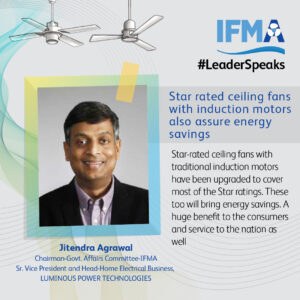Star rated ceiling fans with induction motors also assure energy savings!
The Indian Ceiling fan industry is on the advent of a huge revolution. With the new mandatory Star Rating regime soon to be implemented by the Bureau of Energy Efficiency (BEE), the face of the industry will undergo a distinct makeover. Before the fan industry, numerous other product industries in India have been at the same juncture. With energy conservation being a global mantra and India being committed to the cause, its various industries have made their contribution by creating and promoting products which save power for the consumer and the country.
While a changeover of this nature at an industry level is always challenging for all players involved, it is a significantly tougher task this time for the Indian fan industry. The magnitude of the change that the industry will go through can be gauged by the fact that 95% of the Ceiling fans which are sold today by the industry do not qualify for even a 1 Star rating under the revised norms of the BEE. Therein lies the challenge, but with challenges there always come opportunities.
At the heart of a Ceiling fan lies the motor, and it is this motor which decides how efficiently a fan performs. The new era of efficiency calls for a much more efficient motor at the heart of the fan; and for many, the answer lies in the new technology called Brushless Direct Current or BLDC Motor. This technology comes bearing fruits like 50% less power consumption and consistent performance across a large voltage range, resulting in a sure shot way to a 5 Star BEE Rating. While there is no doubt on the positives that this technology provides, the ride for adoption of BLDC will not be as smooth as it appears to be.
The BLDC Motor technology depends on an electronic controller and permanent magnets. With the ongoing global crisis for electronic parts and the selective geographical availability of magnets, the industry will not be able to convert a large part of its offerings into BLDC motors, even if it wants to. Then there is the issue of cost. The BLDC motor currently costs 2.5x-3x of current fan motor costs and the aforementioned factors are not going to make costs softer in the foreseeable future. While the Indian consumer is conscious of energy efficiency and this warrants more efficient products; they may not be ready to and, in a lot of cases, may not even have the ability to pay a significant premium to adopt them. Therefore, the Ceiling Fan product range will have to depend on the old war horse which has carried its load for more than half a century – the Induction Motor.
It was believed for a long time that the fan industry had achieved a high level efficiency with the induction motor. After all, this motor was performing admirably to address the dual needs of high air delivery at an affordable cost for the tropical but not so affluent Indian consumer. But with the exigent situation that the industry faces today, the brightest minds in this trade have challenged themselves and are bringing out levels of efficiency which were previously unheard of and thought to be unachievable by the humble induction motor. As of this time, engineers of the industry have been able to develop induction motors for Ceiling Fans which provide up to 40% energy saving at a cost delta which is significantly lesser than that of the BLDC motor.
While BLDC is undoubtedly the future of motor technologies for fans, I do not believe that the induction motor has run its course. It is still here to stay, and with the industry putting its might and minds into making it a better performing and a more efficient device, Ceiling fans with induction motors will continue to remain the bread and butter for this industry for years to come.







